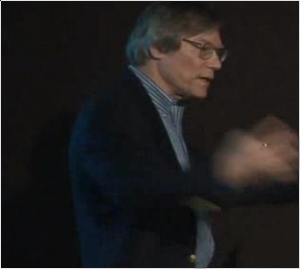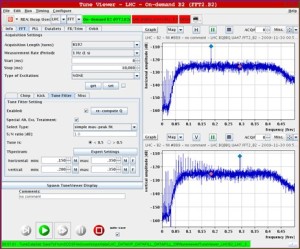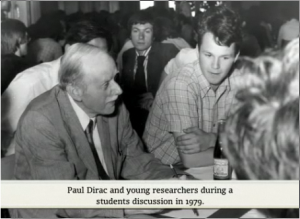 The Institute of Physics’ Isaac Newton medal was awarded this year to Alan Guth, of inflation fame, and his talk is available at the IoP’s website. The talk is devoted to explaining how great and awesome the inflationary theory is, including the usual reasons it’s believed by many to be correct: it explains the large-scale homogeneity of the universe (by causally connecting in the past regions that are unconnected after the inflationary period) and supposedly predicts a smoothed out geometry with an average mass density close to its critical point (that is, a universe with flat spatial sections). There’s also some talk about eternal inflation and pocket universes, which i didn’t understand well enough to comment on: this article by Guth himself is a good way to learn more.
The Institute of Physics’ Isaac Newton medal was awarded this year to Alan Guth, of inflation fame, and his talk is available at the IoP’s website. The talk is devoted to explaining how great and awesome the inflationary theory is, including the usual reasons it’s believed by many to be correct: it explains the large-scale homogeneity of the universe (by causally connecting in the past regions that are unconnected after the inflationary period) and supposedly predicts a smoothed out geometry with an average mass density close to its critical point (that is, a universe with flat spatial sections). There’s also some talk about eternal inflation and pocket universes, which i didn’t understand well enough to comment on: this article by Guth himself is a good way to learn more.
Dr Guth is extremely happy about the fact that estimates for the ratio of the observed over the critical density ( ) have jumped during the last decade from the 0.2-0.3 range to a value almost exactly equal to 1, which corresponds to the flat model. The correction comes from taking bringing dark energy into the picture, and the second half of the talk is devoted to some speculations as to its mysterious origin. To Guth, the most plausible explanation is that this dark energy corresponds to the vacuum energy density (
) have jumped during the last decade from the 0.2-0.3 range to a value almost exactly equal to 1, which corresponds to the flat model. The correction comes from taking bringing dark energy into the picture, and the second half of the talk is devoted to some speculations as to its mysterious origin. To Guth, the most plausible explanation is that this dark energy corresponds to the vacuum energy density ( ), but there’s this little problem that quantum field theory predicts an infinite value for it. Even if you try to introduce an (arbitrary) ultraviolet cut in the calculation at the usual Plank energy, the value obtained is some 120 orders of magnitude greater than the observed one. String theory and the landscape to the rescue! Which of course explains nothing, in my opinion.
), but there’s this little problem that quantum field theory predicts an infinite value for it. Even if you try to introduce an (arbitrary) ultraviolet cut in the calculation at the usual Plank energy, the value obtained is some 120 orders of magnitude greater than the observed one. String theory and the landscape to the rescue! Which of course explains nothing, in my opinion.
Guth’s last resort is the anthropic principle, according to which  is so low because it’s the only way intelligent (?) beings would be here to observe it, and then uses an analogy so broken that i’m sure i’m missing something obvious. It goes as follows: Kepler initially thought that the radius of the orbits of planets in the solar system should have values deducible from geometrical considerations alone, but, as we all know, that’s not the case: their concrete values could be different just by changing the initial conditions leading to the formation of the solar system. So it is with
is so low because it’s the only way intelligent (?) beings would be here to observe it, and then uses an analogy so broken that i’m sure i’m missing something obvious. It goes as follows: Kepler initially thought that the radius of the orbits of planets in the solar system should have values deducible from geometrical considerations alone, but, as we all know, that’s not the case: their concrete values could be different just by changing the initial conditions leading to the formation of the solar system. So it is with  : since we have no way of computing its unexpectedly low value, it must be that the reason for it is that we exist. This argument is so plainly wrong that, as i said, i’m sure i’m misunderstanding (perhaps one of my two or three readers will set the record straight in the comments).
: since we have no way of computing its unexpectedly low value, it must be that the reason for it is that we exist. This argument is so plainly wrong that, as i said, i’m sure i’m misunderstanding (perhaps one of my two or three readers will set the record straight in the comments).
Other than that, and the fact that it feels at times like a commercial (including some arguments pretty close to straw men when he shows the curves matching the observations of the microwave background (without any mention, by the way, to the possible discrepancies for low terms of the multipolar expansion)), the talk is entertaining and gives a good, if quick, overview of commonly accepted wisdom on the field these days. So, if you have a grain of salt handy and don’t mind a bit of hand-waving, just ignore my rants and go for it.
(While you’re at it, i’ll be giving a try to last year’s winner, Anton Zeilinger, and his talk on quantum information and the foundation of quantum mechanics).








